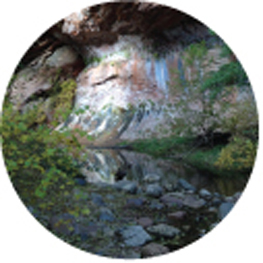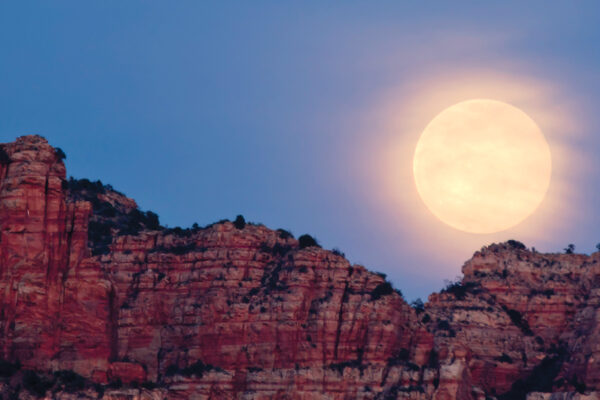Sedona Monthly is a proud supporter of PrintReleaf, a program that certifiably reforests both American forests and those of developing countries. PrintReleaf partners with small organizations around the world to reforest areas that have been stripped of trees. Planting trees creates jobs, and creates a circle of sustainability. Those trees will provide habitats for wildlife, allowing animals to thrive and flourish. Check our social media feeds to keep up with where the trees are currently being planted.
Sedona Monthly is printed using an environmentally-sound, sustainable printer – at a significant additional cost to us – because we feel that it aligns with our values. Sedona Monthly is printed only with vegetable-oil based inks. All of the Sedona Monthly printing inks are non-toxic to the environment.
![]() That’s the logo that means you can recycle this magazine.
That’s the logo that means you can recycle this magazine.
![]() That’s the Elemental Chlorine Free certification awarded because while Sedona Monthly is printed on beautiful, gleaming white paper, it is done so without harmful bleaching techniques.
That’s the Elemental Chlorine Free certification awarded because while Sedona Monthly is printed on beautiful, gleaming white paper, it is done so without harmful bleaching techniques.
This extra production process, this extra step, ensures that the environment is protected. Sedona Monthly also is created with the latest green production and sourcing techniques including:
- Responsibly and sustainably sourced paper.
- Proper recycling of every print plate, every piece trimmed, literally every scrap.
In addition to all of the techniques and certifications above to reduce our own environmental footprint, Sedona Monthly supports countless other regional green causes too.
Learn more about organizations in and around Sedona that are contributing toward a more sustainable future here and on sedonamonthly.com.
SEDONA RECYCLES
Sedona Recycles is an educational nonprofit that has been serving the Sedona community for 30 years. The organization offers waste reduction information, reuse opportunities and recycling services. The recycling center on Shelby Drive and Sedona Recycles’ four drop off locations in the city of Sedona provide the opportunity to recycle 7 days a week, 24 hours a day. Our collection method of multi-stream recycling is able to achieve a 98 percent recovery rate when compared to other collection methods. The organization recycles Sedona Monthly and also offers them in its free magazine area. After the magazines are recycled along with other paper, they are baled and shipped to Phoenix. Once there, the paper can to be used to make blow-in insulation for housing. Or the magazines are sent to paper mills to make recyclable cardboard cores for products or egg cartons. Unlike most recycling facilities, Sedona Recycles offers extra services including Styrofoam recycling, cork recycling, reuse opportunities for bubble wrap and packing peanuts, magazines and books, electronics recycling and household battery recycling. Because of our attention to proper collection, Sedona Recycles became one of only two recycling facilities in the U. S. to receive certification in 2019 from the Glass Recycling Coalition. Sedona Recycles estimates that it has recycled 3,000 tons or 6 million pounds of recyclable materials.

KEEP SEDONA BEAUTIFUL
Keep Sedona Beautiful (KSB) is a founding member of the Sustainability Alliance. KSB communicates the need for each of us to make lifestyle changes in order to advance toward a sustainable economy. KSB is taking the message to heart, making sure that sponsored events such as the Native Plant Workshop and the Annual Awards event are certified zero-waste events. KSB has emphasized sustainability in its quarterly newsletter and in Speaker Series lectures. The KSB-led movement to protect dark skies throughout the Verde Valley is in fact an effort focused in sustaining and improving the lack of light pollution. Additionally, KSB was a contributor in developing the Chamber of Commerce’s Sustainable Tourism Plan and is the lead partner for four of the plan’s tactics. You can read the entire plan on page 22. One of KSB’s most visible and oldest initiatives is to make litter invisible. The organization cleans some 70 miles of area roads and highways. KSB volunteers help sustain the beauty of Red Rock Country.
OAK CREEK WATERSHED COUNCIL
Oak Creek Watershed Council (OCWC) is a 501(c)(3) nonprofit dedicated to preserving the health and integrity of Oak Creek. The organization’s work is focused on public education – to help those who enjoy Oak Creek understand the consequences of their actions and to enlist them as allies in helping the organization to preserve and protect this beautiful treasure. With increased tourism and visitation, Oak Creek’s unique riparian ecosystem is being challenged like never before. Sedona alone gets an estimated 3 million visitors per year, and many want to visit Oak Creek. The result is increases in littering, wildlife disruption, habitat degradation and microbial contamination. OCWC works to mitigate that via stewardship engagement, partnering with local agencies, outreach and education and water quality monitoring. The organization’s mission is maintaining a standard of excellence for watershed stewardship and preserving the integrity of Oak Creek.
SEDONA RED ROCK TRAIL FUND
The Sedona Red Rock Trail Fund (SRRTF) works in partnership with the Red Rock Ranger District and the community to raise funds to maintain and enhance the natural surface trails near Sedona and the Village of Oak Creek. The SRRTF has three primary goals:
- Trails are maintained and enhanced in perpetuity.
- The community understands and values these trails.
- The SRRTF has the capacity to meet the maintenance and enhancement funding shortfall needs of these trails.
FRIENDS OF THE FOREST
Working under the direction of the Red Rock District of the Coconino National Forest, Friends of the Forest’s Trail Maintenance and Construction team helps sustain the land by taking on projects
that control erosion. Well-constructed and maintained trails reduce or eliminate erosion from monsoon rains. The group is also called on to remove social trails in popular hiking areas. Friends of the Forest also communicates the “Leave No Trace” message, asking hikers and bikers to leave trails cleaner than they found them. The Trail Patrol group communicates this message as they interact with visitors and residents on local trails. Visitor Center volunteers also share “Leave No Trace” with tourists. Finally, Friends of the Forest volunteer docents help sustain the area’s cultural heritage at both the V Bar V and Palatki Heritage Sites. The organization’s message to visitors is that cultural resources such as rock art and ancient dwellings can be viewed, but should never be touched. To last another 800 years, cultural resources need to be treated with the respect and care that they deserve.
FRIENDS OF THE VERDE RIVER
Friends of the Verde River is dedicated to a healthy Verde River system, which includes Oak Creek, Sycamore Creek and West Clear Creek. There are over 500 miles of streams in the watershed, including the 190-mile Verde River. The Verde River supports local economies including recreation, farming, ranching and providing drinking water. The Sedona Verde Valley region is dependent on flowing streams and creeks. Friends works with many to sustain river flows, restore habitat and build community support that sustains local, vibrant economies for the future.
SUSTAINABILITY ALLIANCE
The Sustainability Alliance is a coalition of 10 local nonprofits representing a wide range of different sustainability-related issues: water, waste, energy, climate, food and hunger. Darcy Hitchcock, the co-founder of the Sustainability Alliance, tells us that the organization tries to identify what’s falling through the cracks between the organizations and invent programs that help. One example is the Sustainable Business Certification, which assesses what businesses are and can be doing to be more sustainable and then gives them public recognition. The organization also helps events go zero-waste in addition to educating teachers on how to integrate sustainability into their schools and classrooms. The Sustainability Alliance provides integrated recommendations to decision-makers and helps communities develop sustainability plans.
VERDE VALLEY CYCLISTS COALITION
The mission of the Verde Valley Cyclists Coalition (VVCC) is to improve the bicycling environment, facilities, quality of life in the region and encourage bicycle use as an energy-efficient, economical, non-polluting, healthful and enjoyable form of transportation and recreation. The vision of the organization is to create a world-class bicycle environment in the greater Verde Valley region. The VVCC is a 501(c)(3) non-profit founded in 2004 to promote road and mountain bike advocacy in, and around, the Verde Valley of Northern Arizona. VVCC has approximately 185 members from all parts of the Verde Valley. The organization’s successes include:
- Since 2015, raised more than $100,000 for trail work in the Coconino National Forest.
- 40 plus members volunteer for Red Rock Bike Patrol on National Forest trails.
- Advocate for trail sustainability, maintenance and trail user experiences.
- Provide more than 400 plus hours annually for trail maintenance and improvements.
- Raised more than $140,000 since July 2019 for youth, road and mountain bike programs.
SEDONA CHAMBER OF COMMERCE
The Sedona Chamber of Commerce & Tourism Bureau unveiled its Sustainable Tourism Plan in 2019. The Sedona Sustainable Tourism Plan responds to the challenges posed by a high number of visitors with actions ranging from environmental stewardship of Sedona’s famous red rocks to reducing noise, traffic congestion and overcrowding at popular locations. The four pillars of the Sustainable Tourism Plan focus on balancing and enhancing residential quality of life, protecting fragile lands, creating memorable visitor experiences and growing a strong economy. The plan includes:
- Spreading visitation more evenly throughout the year to reduce crowds, traffic and environmental impacts during peak seasons of spring and fall.
- Investing in infrastructure improvements and public transit to reduce congestion.
- Sensitizing visitors to the delicate Sedona environment and small town quality of life.
- Encouraging sustainable experiences for tourists, such as carbon footprint reduction and “voluntourism” environmental maintenance and cleanup projects.
- Developing new visitor experiences that emphasize sustainability as a Sedona value.
- Engaging more with residents to improve understanding of tourism benefits and impacts.
- Using technology to reduce traffic and congestion, such as apps that deliver live parking information and sedonasecret7.com, a website that promotes lesser visited sites.
Part of the Sustainable Tourism Plan includes the Sedona Cares Pledge. The pledge includes nine components that reflect input from Sedona residents during the two year development of the Sedona Sustainable Tourism Plan. Visitors can sign and see the entire pledge at SedonaCares.com.
GARDENS FOR HUMANITY
Gardens for Humanity was founded in 1996 by Adele Seronde, an artist, poet, writer and community activist. Gardens for Humanity’s mission is to develop and share its relationships with humanity and nature through gardening, art and education. Gardens for Humanity current projects in Sedona and the Verde Valley of central Arizona include assisting in the development of home and community gardens, school gardens, art and environmental education. Gardens for Humanity also serves as a resource for the development of local agriculture and sustainable food systems. In all these areas, the organization strives to help people of all ages develop the skills, awareness and desire to grow food and care for the environment. At the heart of the organization’s task is education. The organization hopes to create a sustainable community to give children and all members of our community the values, tools, understanding, leadership skills and experiences we need to seek and regain balance with the natural world.












